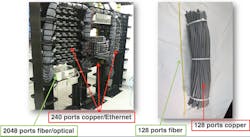Blog: Choosing a smarter LAN option for smart buildings in the 21st century
Repeating designs that have proven to work over decades is sensible, but is it the smartest choice? Fiber cabling infrastructure is not new. It has existed about as long as LANs have been common in buildings. For much of that time, however, a total fiber-based solution has been a higher cost choice and therefore adopted only where bandwidth requirements could not be satisfied using previous choices. Having passed the 1/6th mark of the 21st century though, choosing a fiber-based LAN solution is now lower cost to implement and operate.
POL provides significant space-savings advantages versus traditional copper-based approaches as well as lower cost.
All factors being equal, lower cost is commonly the only factor required to inform the smartest infrastructure choice. And passive optical LAN (POL) offers added efficiency advantages, including lower power consumption, lower physical weight, and smaller physical footprint to name a few. The result is even greater total cost savings. So, why has adoption of POL using fiber infrastructure been slower than it arguably should have been to date? Lack of awareness that the scorecard has changed is part of the explanation, though many decision makers that have the awareness remain resistant to making the switch.
This makes sense. In the overall scope of a building project, the LAN is a very small amount of the overall cost of the project, so a focus on cost savings draws attention elsewhere. For those directly involved with technology infrastructure, repeating familiar designs is easier, especially if they are not being challenged to think differently and look for efficiency and modernization opportunities.
No one can predict this will change overnight, but 2019 has the makings for a shift in momentum for POL, supported by the smart building movement and driven by several trends:
- SaaS – Classic LANs were originally designed to carry traffic between computers in a building or campus. These days, a LAN connects most users to their software-as-a-service (SaaS) applications running in the cloud. POL is an ideal technology for extending broadband Internet to LAN users and provides a superior connection experience to users of SaaS applications.
- Data growth – Deploying classic LAN technologies still works in many cases, making it easier to give up a cost-saving opportunity to avoid having to introduce change. Yet 4K video is just one example of how data growth is pushing the limits of classic infrastructure. Fiber is the 21st century medium for LAN, and POL enables capacity growth at a fraction of the equipment and cabling required with classic LAN.
- Internet of Things (IoT) – Smart buildings are defined by sensors, devices, and systems in the building connected to the LAN to operate more efficiently. IoT is no longer just a buzzword, and classic LAN technology was never designed to support a network robust enough to stay ahead of such compounding demand. Designed for and proven by the most demanding environments, POL can meet the needs of humans and machines in smart buildings.
- Density – Advances in WiFi like 802.11ax not only carry more traffic, they can support a large number of users and devices in a smaller area. In that small area, every user has several connected devices, they are surrounded by IoT devices, and each is expected to have fast access. POL requires a fraction of the power and floor space of classic LAN, enabling a higher density environment.
- Investment protection – Technologies such as virtual reality/augmented reality, machine learning/artificial intelligence, and others are expected to continue advancing. Thinking further, however, what trends will there be 30 years from now, and what type of bandwidth and connection experience will applications require then? POL as a lower-cost medium deployed today will provide utility and return on investment for many decades beyond what is feasible with copper-based solutions.
Efficiency and costsavings often have not informed choosing new LAN technology to date, but the business case for choosing POL will only accelerate. Smart buildings arguably should be the business factor that forces the tipping point for the most sensible LAN option in new projects. Looking at the 21st century in total, it is not a matter of if POL will become the smartest choice. Rather, it is a matter of when those charged with making choices challenge themselves and others working with them to enable their buildings to be as smart as they can be.
Mario Blandini is head of global marketing at DZS and marketing chairman for the Association for Passive Optical LAN.

